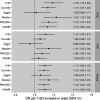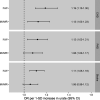Urate, Blood Pressure, and Cardiovascular Disease: Evidence From Mendelian Randomization and Meta-Analysis of Clinical Trials
- PMID: 33356394
- PMCID: PMC7803439
- DOI: 10.1161/HYPERTENSIONAHA.120.16547
Urate, Blood Pressure, and Cardiovascular Disease: Evidence From Mendelian Randomization and Meta-Analysis of Clinical Trials
Abstract
Serum urate has been implicated in hypertension and cardiovascular disease, but it is not known whether it is exerting a causal effect. To investigate this, we performed Mendelian randomization analysis using data from UK Biobank, Million Veterans Program and genome-wide association study consortia, and meta-analysis of randomized controlled trials. The main Mendelian randomization analyses showed that every 1-SD increase in genetically predicted serum urate was associated with an increased risk of coronary heart disease (odds ratio, 1.19 [95% CI, 1.10-1.30]; P=4×10-5), peripheral artery disease (1.12 [95% CI, 1.03-1.21]; P=9×10-3), and stroke (1.11 [95% CI, 1.05-1.18]; P=2×10-4). In Mendelian randomization mediation analyses, elevated blood pressure was estimated to mediate approximately one-third of the effect of urate on cardiovascular disease risk. Systematic review and meta-analysis of randomized controlled trials showed a favorable effect of urate-lowering treatment on systolic blood pressure (mean difference, -2.55 mm Hg [95% CI, -4.06 to -1.05]; P=1×10-3) and major adverse cardiovascular events in those with previous cardiovascular disease (odds ratio, 0.40 [95% CI, 0.22-0.73]; P=3×10-3) but no significant effect on major adverse cardiovascular events in all individuals (odds ratio, 0.67 [95% CI, 0.44-1.03]; P=0.07). In summary, these Mendelian randomization and clinical trial data support an effect of higher serum urate on increasing blood pressure, which may mediate a consequent effect on cardiovascular disease risk. High-quality trials are necessary to provide definitive evidence on the specific clinical contexts where urate lowering may be of cardiovascular benefit.
Keywords: blood pressure; cardiovascular diseases; odds ratio; systematic review; uric acid.
Figures






References
-
- Li X, Meng X, Timofeeva M, Tzoulaki I, Tsilidis KK, Ioannidis JP, Campbell H, Theodoratou E. Serum uric acid levels and multiple health outcomes: umbrella review of evidence from observational studies, randomised controlled trials, and Mendelian randomisation studies. BMJ. 2017;357:j2376 doi: 10.1136/bmj.j2376 - PMC - PubMed
-
- Li X, Meng X, He Y, Spiliopoulou A, Timofeeva M, Wei WQ, Gifford A, Yang T, Varley T, Tzoulaki I, et al. Genetically determined serum urate levels and cardiovascular and other diseases in UK Biobank cohort: a phenome-wide mendelian randomization study. PLoS Med. 2019;16:e1002937 doi: 10.1371/journal.pmed.1002937 - PMC - PubMed
-
- Tin A, Marten J, Halperin Kuhns VL, Li Y, Wuttke M, Kirsten H, Sieber KB, Qiu C, Gorski M, Yu Z, et al. ; German Chronic Kidney Disease Study; Lifelines Cohort Study; V. A. Million Veteran Program. Target genes, variants, tissues and transcriptional pathways influencing human serum urate levels. Nat Genet. 2019;51:1459–1474. doi: 10.1038/s41588-019-0504-x - PMC - PubMed
Publication types
MeSH terms
Substances
Grants and funding
- RG/13/13/30194/BHF_/British Heart Foundation/United Kingdom
- MC_QA137853/MRC_/Medical Research Council/United Kingdom
- DH_/Department of Health/United Kingdom
- MC_UU_00002/7/MRC_/Medical Research Council/United Kingdom
- IK2 CX001780/CX/CSRD VA/United States
- MR/S019669/1/MRC_/Medical Research Council/United Kingdom
- 204623/Z/16/Z/WT_/Wellcome Trust/United Kingdom
- 1004231/MRC_/Medical Research Council/United Kingdom
- MC_PC_17228/MRC_/Medical Research Council/United Kingdom
- RE/18/4/34215/BHF_/British Heart Foundation/United Kingdom
- RG/18/13/33946/BHF_/British Heart Foundation/United Kingdom
- 204623/WT_/Wellcome Trust/United Kingdom
- C31250/A22804/CRUK_/Cancer Research UK/United Kingdom
- CH/12/2/29428/BHF_/British Heart Foundation/United Kingdom
- 203928/Z/16/Z/WT_/Wellcome Trust/United Kingdom
LinkOut - more resources
Full Text Sources
Other Literature Sources

